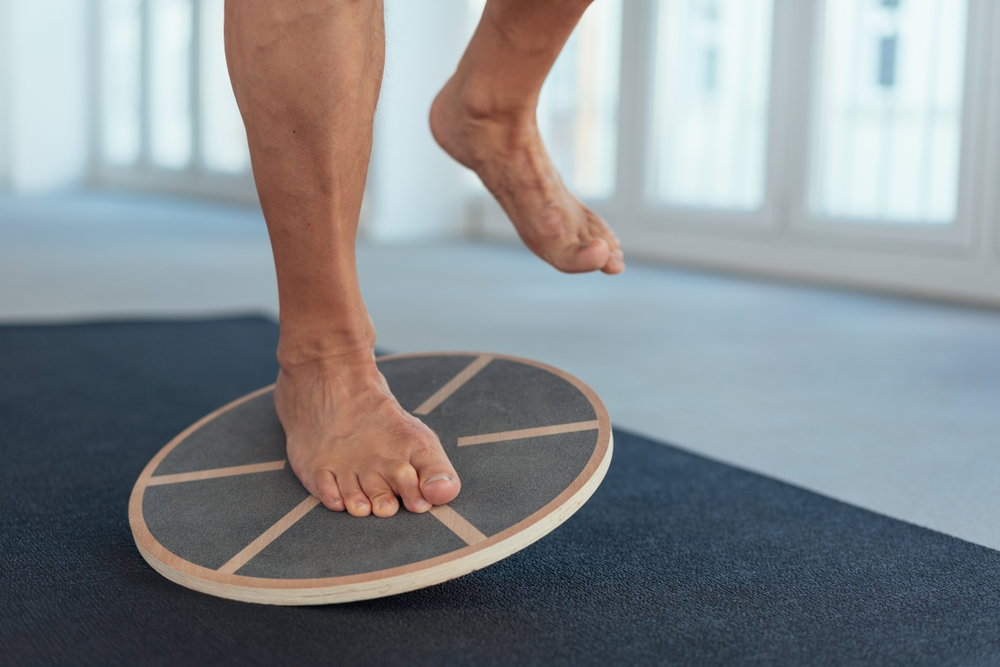Many people falsely believe ankle sprains get better on their own. Resting a sprained ankle and not getting the appropriate rehab sets you up for long-term problems. Chronic ankle instability occurs when mobility and control of your ankle are lost after a sprain. Loss of control leads to repetitive sprains and an unstable feeling during functional tasks or sports. Thankfully, special exercises for chronic ankle instability will help you regain control and strength of your ankle.
More than two-thirds of people who sustain an ankle sprain will develop chronic ankle instability. Many of these people are athletes but non-athletes of any age are also susceptible. This article shows you 5 neuromuscular training exercises proven to help people with chronic ankle instability.
Neuromuscular and Strength Training Proven to Help Chronic Ankle Instability
A 2022 study published in the Journal of Healthcare looked at 67 athletes with chronic ankle instability. Participants were separated into 3 groups. One group did 8 weeks of strength training with resistance bands. The second group did 8 weeks of neuromuscular training exercises focused on balance and stability. The third group received no treatment.
Both neuromuscular training and strength training groups improved in all areas assessed. Both groups showed significant improvements in dynamic balance, functional and sport status, subjective feeling of instability, and ankle range of motion. Participants receiving no treatment made no improvements.
This study proves that both strength training and neuromuscular training exercises are effective for people with chronic ankle instability.
Exercises for Chronic Ankle Instability: Neuromuscular Training

A feeling of instability is the most common complaint by athletes who have suffered ankle sprains. Strengthening exercises help but athletes also need balance and stability training to return to their sport.
Neuromuscular training involves progressive exercises aimed at improving single-leg balance. The program starts with static balance exercises done standing in one place.
As strength and stability improve, dynamic exercises are initiated. These exercises incorporate upper body movements, jumping, landing, and cutting maneuvers. The next 5 exercises in this article are a simple progression of neuromuscular training exercises for people with ankle instability.
Single-Leg Balance
You should be able to stand on one leg with little or no sway of your body for at least 20 seconds. You’d be surprised how many seemingly healthy people cannot do this.
For practice, stand tall with your feet together and hands on your hips. Lift one leg so your knee is at the height of your hip. Bend your knee slightly. Hold this position for up to 30 seconds. Stay tall. Do at least 3 reps on each side.
To progress this exercise, slowly swing your opposite knee up and down in a controlled fashion. Do 10 slow reps without losing your posture. A final progression is to perform either of these exercises on an unstable surface like a pillow or Airex pad.
1-leg Medicine Ball Toss
After you can stand on one leg for 30 seconds, you can add upper body challenges. The single-leg med ball toss is a fun and challenging way to work on your balance.
Start with a 2- or 4-pound medicine ball chest pass. Once you can perform 10 reps without losing your posture, try overhead or side throws. Shoot for 3 sets of 10-20 reps on each leg.
1-Leg RDL
The single-leg Romanian deadlift is a more challenging progression. Stand on one leg with one hand on your hip. Slowly bend at the waist and attempt to touch your foot with your opposite hand. Your opposite leg remains straight and in line with your trunk.
Do 8-12 reps on each side. We recommend 2 to 3 sets without weight to start. Once you can perform this exercise without losing your posture, add a 10-pound kettlebell or dumbbell.
Forward-Backward Jumps
The first 3 exercises above are more static than dynamic. To train dynamic balance, we recommend progressing to single-leg jumps.
Balance on one leg with both hands on your hips. Jump forward and back on one leg for 6 reps. Jump as far as you can without losing your balance. At first, perform this exercise slowly. Control each landing by balancing for 3 seconds. Maintain good posture with your hands on your hips with each jump and landing.
Once you can perform these jumps slowly with good control and balance, increase the speed. Now, jump quickly forward and back without losing your balance or posture.
Lateral Jumps
Side-to-side jumps are more challenging for people with ankle instability. Perform these jumps only after you gained some level of proficiency and confidence with forward-backward jumps.
Balance on one leg with both hands on your hips. Jump side to side on one leg for 6 reps. Jump as far as you can without losing your balance. At first, perform this exercise slowly. Control each landing by balancing for 3 seconds. Maintain good posture with your hands on your hips with each jump and landing.
Once you can perform these jumps slowly with good control and balance, increase the speed. Now, jump quickly side to side without losing your balance or posture.
See Your Physical Therapist for a Personalized Program

The 5 exercises included here are a great place to start if you are suffering from chronic ankle instability. We recommend you perform neuromuscular training exercises 3 to 4 days per week. Expect improvements in strength and your sense of stability in just a few weeks.
You may need different or more advanced progressions to maximize your improvements. Your physical therapist will help you find the right exercises. Also, if you continue to experience ankle stiffness, manual physical therapy will help restore your mobility.
The doctors of physical therapy at BSR have been helping people in Southern Ocean County move without pain since 2007. Contact one of our offices to schedule an initial evaluation with your physical therapist.

